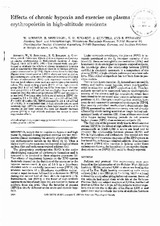Mostrar el registro sencillo del ítem
Effects of chronic hypoxia and exercise on plasma erythropoietin in high-altitude residents
| dc.contributor.author | Schmidt, W | |
| dc.contributor.author | Spielvogel, H | |
| dc.contributor.author | Eckardt, KU | |
| dc.contributor.author | Quintela, A | |
| dc.contributor.author | Peñaloza, R | |
| dc.date.accessioned | 2019-05-28T14:39:18Z | |
| dc.date.available | 2019-05-28T14:39:18Z | |
| dc.date.issued | 1993 | |
| dc.identifier.uri | http://repositorio.umsa.bo/xmlui/handle/123456789/20727 | |
| dc.description.abstract | Abstract The present study was performed to evaluate the effects of chronic inspiratory hypoxia and its combination with physical exercise on plasma erythropoietin concentration ([EPO]). Eight natives from the Bolivian Plateau were investigated at 3,600 m above sea level at rest as well as during and up to 48 h after exhaustive exercise (EE) and 60 min of submaximal (60%) cycle ergometer exercise (SE). Ten sea-level subjects were used as a control group for resting values. The mean resting plasma [EPO] of the high-altitude group (19.5 +/- 0.7 mU/ml) did not differ from that of the sea-level group (18.1 +/- 0.4 mU/ml) but was higher than would be expected from the relationship between [EPO] and hematocrit at sea level. Five hours after both types of exercise, [EPO] decreased by 2.1 +/- 0.8 (EE, P < 0.01) and 1.6 +/- 0.8 mU/ml (SE, P < 0.05); 48 h after SE, [EPO] increased by 2.6 +/- 0.9 mU/ml (P < 0.05). It is concluded that 1) high-altitude natives need relatively high [EPO] to maintain their high hematocrit and 2) exercise at low basal arterial PO₂ does not directly increase plasma [EPO] in high-altitude residents but seems to exert suppressive effects. | es_ES |
| dc.language.iso | en | es_ES |
| dc.publisher | American Physiological Society | es_ES |
| dc.subject | ADAPTACIÓN A LA ALTURA | es_ES |
| dc.subject | SUMINISTRO DE OXÍGENO | es_ES |
| dc.subject | VALOR DEL HEMATOCRITO | es_ES |
| dc.subject | VOLUMEN DE PLASMA | es_ES |
| dc.title | Effects of chronic hypoxia and exercise on plasma erythropoietin in high-altitude residents | es_ES |
| dc.type | Article | es_ES |

